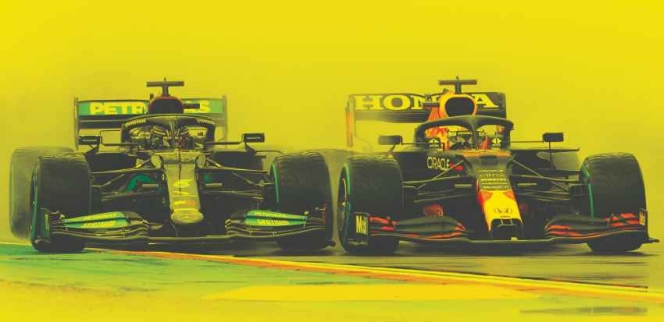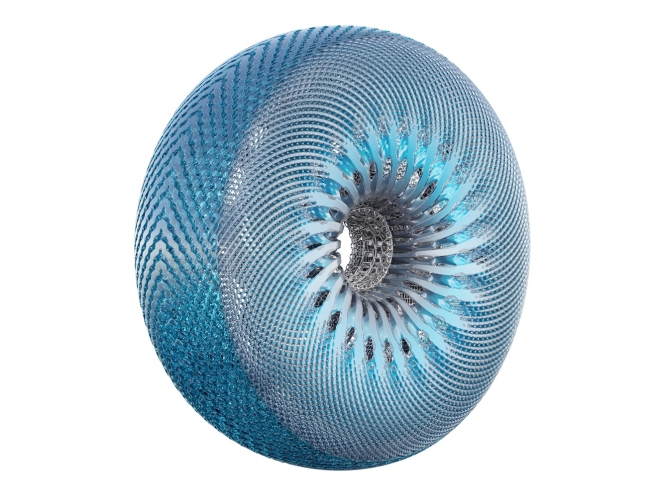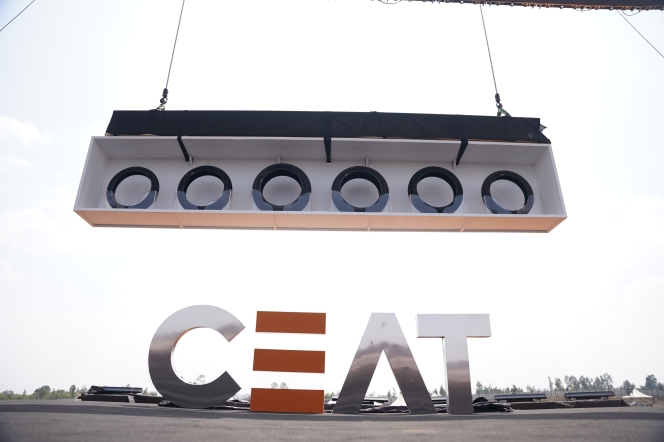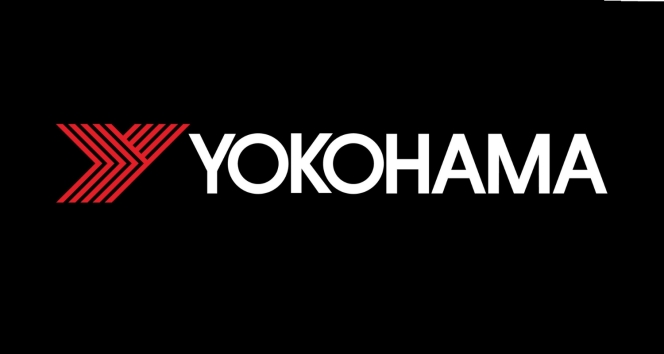Going For The Gap That Doesn’t Exist
- By Venkatesh P Koushik
- October 13, 2021

The first example of this was seen in 1989 when Alain Prost hit Ayrton Senna on the first lap of the final race at Suzuka. While Senna carried on and won the race, he was disqualified for cutting the chicane and thus handing the championship to Prost. Twelve months later, at the same venue, Senna took redemption by deliberately crashing into Prost to win his first F1 championship.
 While F1 took note of the incident, little was done to avoid further incidents, and thus, in 1994, things repeated with Michael Schumacher turning in on Damon Hill to clinch the championship by one point. Schumacher repeated this attempt on Jacques Villeneuve three years later, only to be disqualified from the championship for deliberately hitting another driver. These incidents forced then FIA president Max Mosley to intervene and set up rules to stop drivers from taking out each other. But two decades since the Schumacher incident, no driver has tried to put the rules to the test, barring the 2016 season when tensions were running high between teammates Nico Rosberg and Lewis Hamilton, leading to multiple collisions through the season. But looking at the 2021 season, it seems like the rule will be finally implemented. The heated battle between Hamilton and Max Verstappen is through the roof, with the duo colliding on two occasions in the 2021 season.
While F1 took note of the incident, little was done to avoid further incidents, and thus, in 1994, things repeated with Michael Schumacher turning in on Damon Hill to clinch the championship by one point. Schumacher repeated this attempt on Jacques Villeneuve three years later, only to be disqualified from the championship for deliberately hitting another driver. These incidents forced then FIA president Max Mosley to intervene and set up rules to stop drivers from taking out each other. But two decades since the Schumacher incident, no driver has tried to put the rules to the test, barring the 2016 season when tensions were running high between teammates Nico Rosberg and Lewis Hamilton, leading to multiple collisions through the season. But looking at the 2021 season, it seems like the rule will be finally implemented. The heated battle between Hamilton and Max Verstappen is through the roof, with the duo colliding on two occasions in the 2021 season.
Coming into the 2021 season, things looked heated as Red Bull finally fielded a competitive car that is considered the best on the grid. On the other hand, affected by the recent rules change, Mercedes started on the backfoot during pre-season testing. With protagonists from both teams gunning to clinch the title, things began to heat up from the first race in Bahrain, where the Mercedes and Hamilton won the race after a close wheel to wheel battle with Verstappen. Determined to win the title, Verstappen and Red Bull adopted every tactic in the book to win the next round in Italy and swing the championship in their favour.
With Verstappen aiming for his maiden title and Lewis for his eighth, both drivers gave their 100 percent on the track, resulting in fantastic wheel-to-wheel racing in Bahrain, Imola, Portimao, Barcelona and France that was missing from F1 for over a decade. This close wheel to wheel racing has resulted in the championship swinging both ways, race after race. During the initial phase of the championship, both drivers raced with mutual respect. But just before the summer break, during round 10 of the championship at Silverstone, the rivalry took an ugly turn. Verstappen and Hamilton collided at the Corpse corner on the first lap of the race, resulting in a 51G crash that saw Verstappen spinning into the tyre barrier. This was the spark that ignited it all.
Following the crash, Lewis was handed a 10-sec time penalty which in no way affected the result of the race. In the end, Lewis won his eighth British GP and celebrated in style. This trigged Red Bull team principal Christian Horner, who accused Hamilton of ‘dirty racing’. While the drivers refused to engage in a war of words, the team principals were going at each other. F1 went for its summer break, with Lewis leading the championship by just six points.
Coming back from the summer break, Verstappen won back to back at the Spa-Franco champs and at his home track in the Netherlands.
Just when the war of words had started to settle down and the championship had swung in Red Bull and Verstappen’s favour, the two championship rivals collided on lap 26 of the Italian GP at Monza. Frustrated by an 11.1-second pit stop which put him directly into Hamilton’s path, Verstappen was pushing hard on a fresh set of hard tyres. On lap 26, Hamilton pitted for a new set of tyres and caught McLaren’s Lando Norris and Verstappen at the pit exit. After letting Norris pass, Hamilton stuck to the racing line into the Variante chicane. Seizing the opportunity, Verstappen attacked to the outside of Hamilton. Not yielding, both drivers stuck to their racing lines and collided. The collision saw Verstappen’s car bounce off the sausage kerbs and pitched onto Hamilton’s car, clipping the rear wing and roll hoop of the Mercedes before landing heavily onto the Halo. Both the cars got beached in the gravel with one on top of the other.
A disgruntled Verstappen got off the car and walked away, blaming Hamilton for the crash. Talking post-race, Verstappen complained, “He kept on squeezing me to the left. I expected him to give me space going into turn 2, but he left me without enough road.” Reacting to it, Hamilton, said, “I left him a car’s width going into the first corner and I was ahead going into the corner. The next thing I know, Max was over me. He obviously knew at that point he wasn’t going to make the corner and drove into me.”
After the race, the stewards reviewed the incident and handed Verstappen a three-place grid drop for the Russian GP. The stewards found that Verstappen was never in front of Hamilton and hence was predominantly to blame for the collision. Reacting to the penalty, Mercedes team principal Toto Wolff accused Verstappen of a tactical foul.
Verstappen will be ready for redemption at the Russian GP. Eager to bounce back from his three-place grid penalty and win at the Sochi Autodromo and break Mercedes dominance at a circuit that suits the Mercedes car the best. While the blame game continues, F1 pundits predict that the two title rivals will clash again before the end of the championship. With eight rounds left in the championship, Verstappen leads Hamilton by just five points. It’s all to play for in the championship, with either driver giving it their 100 percent.
With a three-place grid penalty to serve at a track that does not favour the Red Bull Car, will the Milton Keynes-based team opt to take engine penalty and push during the race with a new engine, or will they postpone the new engine for another race? Will Verstappen adopt a more polite approach towards his driving? Will the teams and drivers race fair with mutual respect? We have to wait and watch. But for the fans, this championship is an exciting one that will go down to the wire and enter the record books as the most entertaining season in the recent past. (TT)
- Yokohama Rubber
- GEOLANDAR X-AT
- All-Terrain Tyres
- Racing Tyres
- FIA Extreme H World Cup
- Hydrogen-Powered Motorsport
Yokohama Rubber To Power FIA Extreme H World Cup With GEOLANDAR Tyres
- By TT News
- September 12, 2025

The Yokohama Rubber Co., Ltd. has been selected as the official tyre supplier for the groundbreaking FIA Extreme H World Cup, the world's first hydrogen-powered motorsport series. The company will supply its GEOLANDAR brand of tyres for the championship, which is scheduled to commence next month in Saudi Arabia. The company will also continue to supply GEOLANDAR tyres for the Extreme E off-road electric vehicle series, which holds its final event on 4–5 October in Saudi Arabia.
Central to both the Extreme H and Extreme E series is a shared mission to advance sustainability and equality. The championships serve as dynamic platforms to promote environmental awareness and demonstrate cutting-edge technologies while also enforcing a strict mandate for gender parity by requiring each team to field one male and one female driver. The Extreme H series will feature eight international teams operating the Pioneer 25, a cutting-edge hydrogen fuel cell vehicle capable of generating 550 horsepower and accelerating from 0 to 100 kmph in 4.5 seconds. The global significance of this new championship is expected to draw a worldwide television audience across multiple continents.
As the predecessor to Extreme H, the Extreme E series utilised the high-performance all-electric Odyssey 21 vehicle. All teams competing in the new hydrogen series will also participate in this final Extreme E event, marking the conclusion of the electric championship as it transitions towards a hydrogen future.
In alignment with the environmental principles of these series, Yokohama Rubber will provide a specially developed prototype tyre based on its GEOLANDAR X-AT model. This tyre has been engineered with a significantly increased ratio of sustainable materials, comprising 38 percent renewable and recycled content. It has also been fortified with enhanced durability characteristics to withstand the unique demands of heavy hydrogen-powered and electric off-road racing vehicles.
Hankook Tire Unveils Future Mobility Innovations At 'Design Innovation Day 2025'
- By TT News
- September 12, 2025

Hankook Tire is advancing its future mobility leadership through strategic open innovation and collaborative design projects. This effort was showcased at the company’s recent Design Innovation Day 2025, held at its Pangyo Technoplex headquarters. The event serves as a platform to present new solutions integrating sustainability, innovation and design while reinforcing partnerships with global technology leaders.
A major focus was the unveiling of two key outcomes from Hankook’s ongoing Design Innovation Project. The first was ‘Sustainable Concept Tyre’, an embodiment of the company’s ESG vision. Developed using advanced 3D printing technology, it is constructed from renewable and recycled materials. Its distinctive organic design was realised in collaboration with Harvestance using specialised engineering software.
The second reveal was the WheelBot 2, a multi-directional mobility platform developed with robotics startup CALMANTECH. This advanced robotic wheel system, equipped with tri-axial spherical tyres, demonstrates new possibilities for movement. Its potential was illustrated through a live demonstration of the PathCruizer, a two-seater pod concept powered by the WheelBot technology.
Beyond product reveals, the event highlighted Hankook’s commitment to knowledge sharing, featuring a presentation on 3D printing advancements from LG Electronics. These collaborations are central to Hankook’s strategy of strengthening its technology leadership. Since 2012, the company has partnered with world-renowned design universities and technology firms, consistently earning prestigious international design awards and solidifying the premium stature of its global brand.
CEAT Cuts Tyre Prices Across Portfolio Following GST Rate Reduction
- By TT News
- September 12, 2025

Indian tyre maker to pass full benefit of tax cuts to customers from 22 September
CEAT Limited said on Thursday it would reduce prices across its entire tyre range following the Indian government’s decision to cut goods and services tax (GST) rates on tyres, with the full benefit being passed on to customers.
The Mumbai-based tyre manufacturer said new prices would take effect from 22 September, covering commercial, agricultural, passenger vehicle and two-wheeler segments.
India’s 56th GST Council meeting approved significant reductions in tax rates for the tyre industry. GST on new pneumatic tyres was cut to 18% from 28%, whilst tractor tyres and tubes will attract a reduced rate of 5%.
“We thank the Government of India and the GST Council for their timely and progressive decision to rationalise tax rates in the tyre sector,” said Arnab Banerjee, Managing Director & CEO of CEAT Limited.
“The reduced GST slabs will greatly benefit the tyre industry and consumers alike. Not only will it lower the cost of owning and operating a vehicle for customers across various segments, but by making tyres more affordable to replace, it will also make our roads safer.”
Banerjee added the move would “spur formalisation and greater compliance, while also fostering sustainable growth in the sector.”
The GST rate cuts represent a significant policy shift for India’s automotive sector, where high taxation has been a longstanding concern for manufacturers and consumers.
Yokohama Rubber Recognised As ‘DX Certified Business Operator’ By Japan’s METI
- By TT News
- September 12, 2025

The Yokohama Rubber Co., Ltd. has been officially recognised as a DX Certified Business Operator by Japan's Ministry of Economy, Trade and Industry (METI). The designation, which was granted on 1 September 2025, identifies companies that are thoroughly prepared for digital transformation as outlined by the Digital Governance Code.
This certification acknowledges Yokohama Rubber's comprehensive strategy for digital transformation, which is built on three core objectives: advancing business strategy, contributing to sustainability and reinforcing its IT infrastructure. Central to this effort is the company's proprietary AI framework, HAICoLab (Humans and AI ColLaborate), which drives group-wide digital initiatives. These include improving productivity, innovating processes, developing digital talent and building a global cloud-based IT system. The certification confirms that the company's efforts not only meet METI's stringent criteria but also demonstrate appropriate disclosure of information to its stakeholders.
Moving forward, the company said it will continue to leverage data from its entire value chain to adapt to a dynamic business environment. The company aims to enhance customer value, pursue sustainable innovation and transform its corporate culture to strengthen its competitive position and ensure long-term growth.






Comments (0)
ADD COMMENT